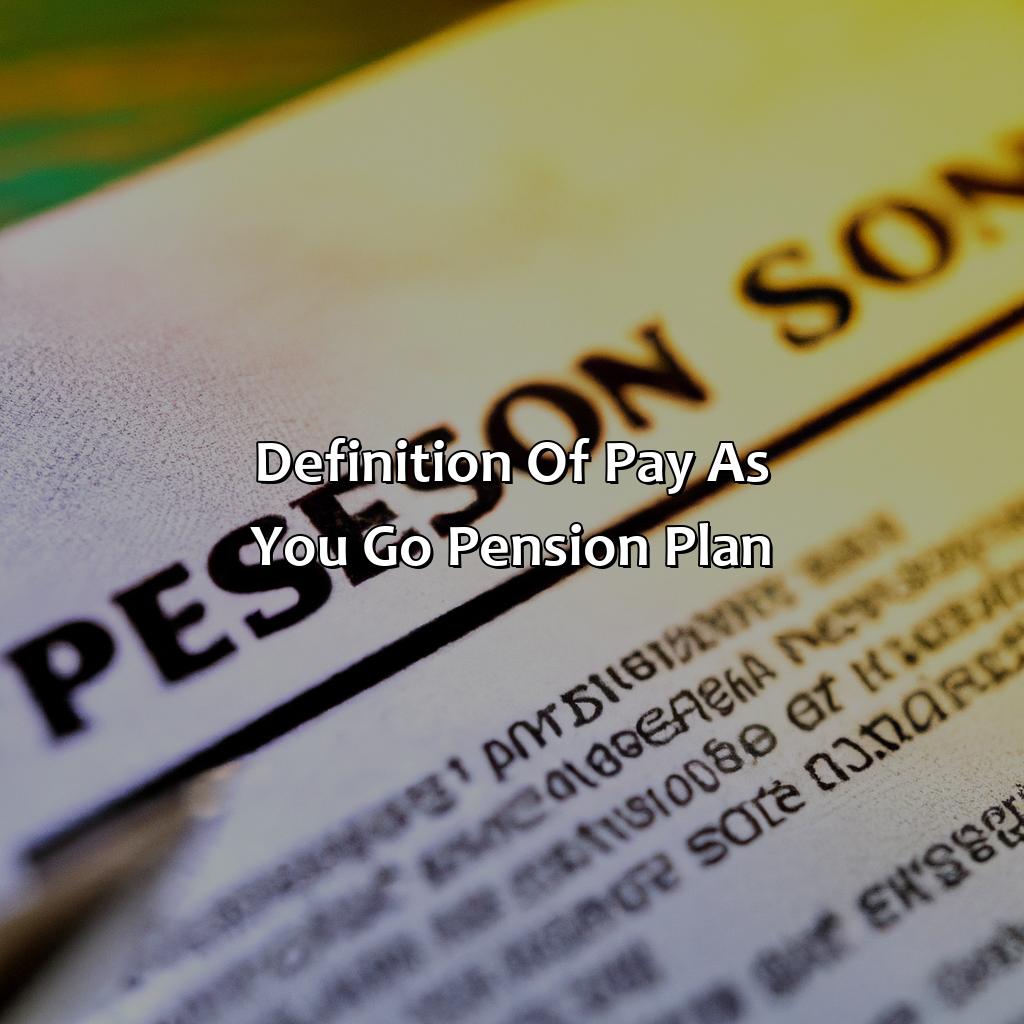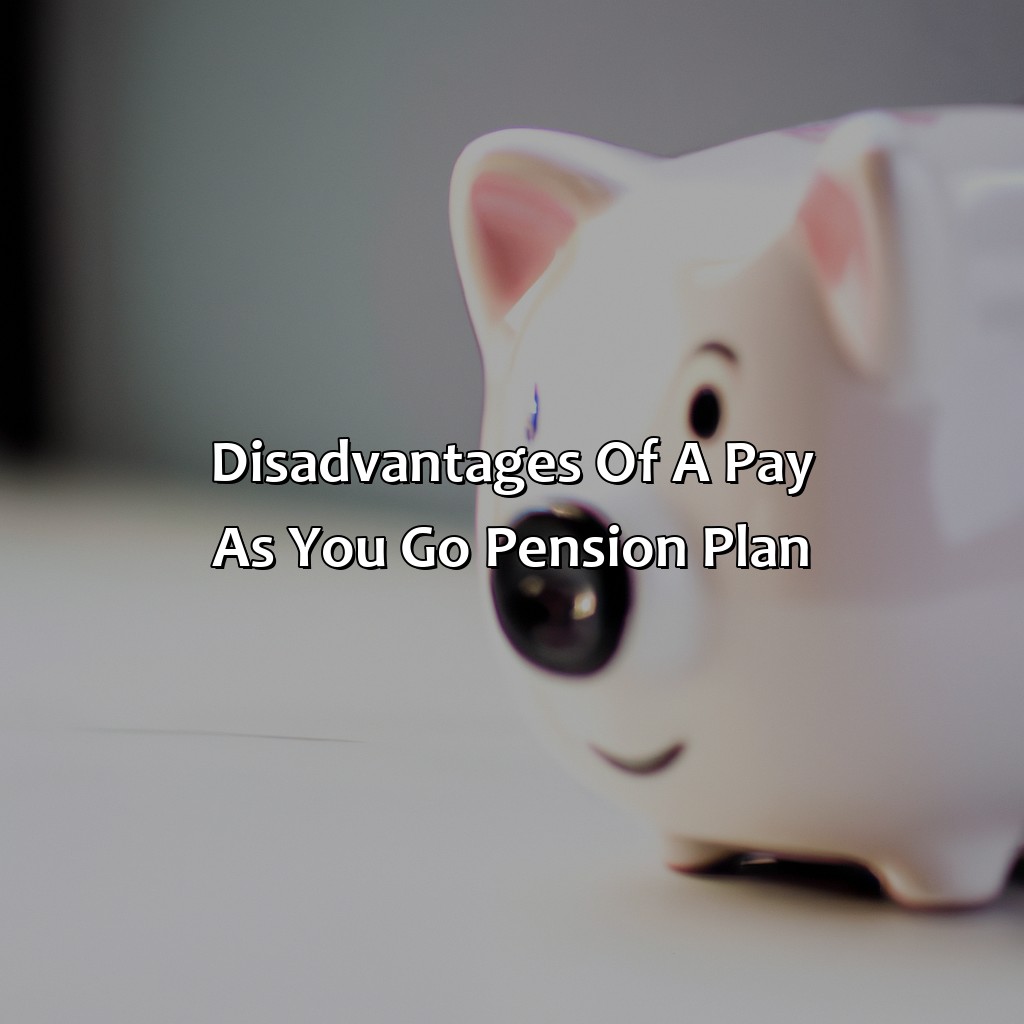What Is A Pay As You Go Pension Plan?
Key Takeaways:
- A Pay As You Go Pension Plan is a social welfare program where current workers pay for the retirement benefits of current retirees.
- Advantages of a Pay As You Go Pension Plan include flexibility in contributions, low initial cost, and no employer liability, making it an attractive option for some individuals and governments.
- Disadvantages of a Pay As You Go Pension Plan include uncertainty of future benefits, dependence on government funding, and possible funding shortfalls, which can lead to difficult decisions and financial strain.
Are you concerned about your retirement savings? Have you considered a pay as you go pension plan? You can find out everything you need to know in this article, designed to provide you with all the information you need to make an informed decision.
Definition of Pay As You Go Pension Plan
Pay As You Go Pension Plan refers to a retirement savings scheme where current workers’ pension contributions pay for the retirement benefits of current pensioners. In other words, a pay-as-you-go pension plan is a system where those currently working pay for those who have retired.
As part of the social security system, this pension plan is common in many countries. It is also known as a defined benefit pension plan, where the employer guarantees a specific payout based on the employee’s salary and years of service. The amount of benefit is calculated based on a percentage of the employee’s salary, often around 1-2%. If you’re wondering how much Sss pension will you get, it depends on various factors such as your contributions and length of service.
This type of pension plan has faced challenges, as increasing life expectancies have resulted in a greater number of retirees and a smaller workforce to contribute to the system. Some governments have attempted to address this by raising retirement ages or introducing additional contributions. If you’re curious about how much Canada Pension Plan you’ll receive, check out our guide.
Interestingly, the pay-as-you-go pension plan was first established in Germany in 1889 by Chancellor Otto von Bismarck, who wished to provide a social security net for the elderly. This later influenced other countries to introduce their own social security systems and pension plans.

Image credits: retiregenz.com by Adam Woodhock
Advantages of a Pay As You Go Pension Plan
A pay as you go pension plan has lots of advantages! It’s flexible, cheap to start, and your employer isn’t liable. That makes it a great retirement savings option for many people. Check it out!

Image credits: retiregenz.com by David Jones
Flexibility in Contributions
With a Pay As You Go pension plan, you have the flexibility to decide the frequency and amount of your contributions. This means that you can adjust your payments in line with changes in your income without any significant impact on your retirement savings.
Furthermore, if you’re wondering when do you pay taxes on a pension plan, this scheme allows you to choose when you start taking benefits as it offers several options for payouts – lump sum, annuity or a combination of both. Hence, you can decide when and how much to withdraw based on current circumstances.
It’s essential to note that switching between plans is possible too. Suppose you’re making regular payments and suddenly face a financial crisis. In that case, you can switch to a reduced contribution scheme without losing any previously accumulated benefits.
Aaranges pensions are pioneers in pay-as-you-go pension schemes that offer high returns and low management fees to facilitate long-term investments at convenient rates.
Don’t miss out on an opportunity to invest seamlessly towards a happy retirement! Talk with experts at Aaranages Pensions today to learn more about Pay-As-You-Go Pension Scheme and start securing your future today!
A pay as you go pension plan is perfect for those who want to save money now, even if it means being broke later. #YOLO
Low Initial Cost
One of the key benefits of a Pay As You Go Pension Plan is its affordability. The initial cost of enrolling in such a plan is less compared to traditional pension plans. This can be an excellent option for people who want to save money for retirement without breaking the bank.
Moreover, with this plan’s low initial costs, individuals can make smaller contributions at regular intervals without fearing financial strain or missing payments that come with a lump-sum payment process. This makes saving manageable and less overwhelming.
It’s important to note that low initial cost does not translate to poor returns. A Pay As You Go Pension Plan is typically designed to offer competitive returns while spreading out contribution payments that ensure each account gets enough time to accrue interest and grow.
If you’re wondering how a pension is paid out, this type of plan is a good option to consider.
Overall, enrolling in a Pay As You Go Pension Plan is an excellent opportunity for people looking for an affordable way to save for their retirement. Many people have successfully leveraged this option and secured their future post-retirement.
True Story:
Mary, 35 years old, wanted to start saving for her retirement but didn’t have enough disposable income at hand- making traditional pension schemes unaffordable. She opted for a Pay As You Go Pension Plan instead, which allowed her to start saving small amounts she could afford over time with no financial strain. Now on track towards securing her future, Mary is glad that she made this decision earlier rather than later.
Finally, a pension plan where your boss doesn’t have to pretend to care about your retirement.
No Employer Liability
With a Pay As You Go pension plan, employers have no financial liability for employees’ pensions. This relieves businesses of the stress and cost of managing pensions for their workers. They are free to focus on other aspects of running their organization, knowing that their employees are able to save for retirement without their assistance.
Furthermore, as employees fund their own pensions through contributions from their paychecks, they develop a stronger sense of responsibility and ownership over their retirement savings. This can lead to better engagement in retirement planning and a greater understanding of personal financial management. If you’re interested to know more about pensions, you may wonder what an occupational pension is.
A Pay As You Go pension plan also offers flexibility for both employers and employees. Employers can set the contribution rates based on the company’s financial performance, while employees can adjust their contributions to fit changing circumstances in their lives.
By implementing a Pay As You Go pension plan, businesses not only reduce costs but also provide an attractive benefit for potential hires. Employees appreciate the opportunity to take control of their own retirement planning, which enhances job satisfaction and promotes long-term loyalty.
Don’t miss out on the advantages of a Category A State Retirement Pension – consider implementing it in your organization today. Your bottom line will thank you in the long run, and your employees will be grateful for the opportunity to take ownership of their financial futures.
Unfortunately, the only downside to a pay as you go pension plan is that you’ll never know when the government might decide to change the rules and start paying in monopoly money.
Disadvantages of a Pay As You Go Pension Plan
Want to comprehend the bad bits of a Pay As You Go Pension Plan? It ensures pensions for present retirees with money from current workers. Uncertainties over future advantages, reliance on government finance, and possible funding shortfalls have been examined.

Image credits: retiregenz.com by Yuval Washington
Uncertainty of Future Benefits
A Pay As You Go Pension Plan’s benefit amount is uncertain and can fluctuate depending on various factors such as inflation, market conditions and life expectancy. This uncertainty can create difficulties for pensioners relying solely on these benefits.
The fluctuations occurring due to government policies, the economy and financial markets worldwide can affect the non-guaranteed pay as you go pension plan negatively. The uncertainties within this scheme are often deemed too significant to provide an adequate income at retirement. Being reliant on a non-guaranteed pension may make funding planning difficult as future retirement income may also be precarious. To understand better, read about what is pension debt and how it affects retirement planning.
Although the Pay As You Go Pension Plan provides security for those who have little cash to spare while working, it is beneficial to make additional provisions to mitigate the uncertainty of future benefits from a pay-as-you-go retirement plan.
If you’re wondering how many years you have to work in Canada to get a pension, it depends on which plan you are enrolled in and your eligibility requirements. It’s important to research and plan ahead for your retirement to ensure you have enough funds to support yourself in your golden years.
Pro Tip: To avoid the uncertainties associated with a Pay As You Go Pension Plan, it s essential to start saving early for your retirement and choose a more reliable and guaranteed plan to ensure you receive adequate funds upon your retirement.
Who needs financial security when you can rely on the government’s budgetary whims?
Dependence on Government Funding
Under a system where pensions are paid as you go, governments must fund payments to retirees from current tax collections. This dependence on government funding means that a pay as you go pension plan can be vulnerable to changes in the economy or demographics of a country. Without enough new taxpayers entering the workforce, such a plan could face financial challenges.
It is essential to note that this type of pension plan relies heavily on consistent economic growth and robust population growth rates. Otherwise, an aging population with long life expectancies could burden the younger generations with increased taxation and debt obligations to sustain their retirement benefits. This approach puts excessive pressure on the government and the taxpayers’ ability to anticipate future costs accurately. To better understand these concerns, it’s important to learn about various pension plans, including the commuted value of pension.
While some countries have successfully implemented pay-as-you-go pension plans for decades, others have faced significant challenges due to structural weaknesses in their economies or poor government management. As an illustration, Spain’s retirement benefit scheme struggled when millions of baby boomers became eligible for benefits under adverse economic conditions. If you are living in Canada, you may want to learn about pension income splitting as a way to optimize your retirement income.
Despite this hardship, the Spanish government was compelled to support all eligible beneficiaries in line with existing legislation. The result was substantial debt and an unclear way forward for balancing its budget amidst unfavorable economic circumstances. Just when you thought it was safe to retire, a possible funding shortfall in your pay as you go pension plan is lurking around the corner like a financial serial killer.
Possible Funding Shortfalls
A possible issue that may arise in a pay as you go pension plan is the presence of funding shortfalls. This means that there may not be enough funds available to cover the promised pension benefits.
This situation may occur due to various reasons, including a high number of retirees or inadequate contributions from active workers. In such cases, the government or employer may have to increase taxes or make extra contributions to address the shortfall.
To mitigate this problem, some suggestions include increasing retirement age or promoting private savings accounts. Both options can boost available funds and reduce reliance on government-sponsored plans like pay as you go pension schemes. Additionally, increasing transparency, encouraging financial education and making timely and fair adjustments can also help ensure proper fund management.
While a pay as you go pension plan provides an opportunity for social security to the retired workforce, it is essential to understand its limitations and take necessary precautions to avoid any funding shortfall issues. Why save for retirement when you can just let future generations foot the bill? Welcome to the world of pay as you go pensions.
Examples of Countries with Pay As You Go Pension Plans
In this section, we will explore various countries that have implemented Pay As You Go Pension Plans. These plans are based on the concept that the current workforce contributes funds to support the current retirees, rather than a separate pension fund for each individual. Here are some examples of countries that have adopted this pension plan:
- France
- Germany
- Japan
- Spain
- United Kingdom
- United States
Each of these countries has its unique way of running their Pay As You Go Pension Plans. Still, they all share the same underlying principle of having the current workforce supporting the current retirees. Of note, in some countries, the provision of these pensions is mandatory and forms a part of the citizen’s social welfare benefits. It is essential to note that the contribution rates and retirement ages differ among these countries. The decision to provide this type of pension plan is dependent on various factors such as the economy and government policies. One example of this pension plan in action is in France, where the pension system is bleeding due to high expenditure on pension payments. The country is proposing a reform of its Pay As You Go Pension Plan as a solution to the problem. The reform aims to fix the current system and avoid a possible collapse in the future. 
Image credits: retiregenz.com by Adam Washington
How to Sign Up for a Pay As You Go Pension Plan
In today s world, it s always better to be prepared financially for the future. One way to do that is by signing up for a pay as you go pension plan. Wondering how to get started? Here s a 3-step guide:
- Research Different Plans: Look into various pay as you go pension plans that are available and assess which one is the best for you based on your income, savings and retirement goals.
- Sign Up: Once you have identified the plan, fill out all the necessary paperwork and submit it to the pension provider. Provide accurate personal information to avoid any discrepancies in the future.
- Make Regular Contributions: After signing up, it s important to make regular contributions to ensure your pension fund continues to grow.
If you are self-employed or have a fluctuating income, a pay as you go pension plan may require adjustments. Be mindful of the contributions you make and keep track of how much you have contributed so far.
Don t miss out on securing your future. Start a pay as you go pension plan today and rest easy knowing you have a solid financial backup for your retirement years.

Image credits: retiregenz.com by David Arnold
Alternatives to Pay As You Go Pension Plans
Investment Options Without the Pay-As-You-Go Scheme
There are alternative paths to save for retirement beyond the pay-as-you-go pension plan.
- Personal Pensions: Individual retirement accounts where an individual contributes regularly to a pot of capital, which then grows based on investment performance.
- Occupational Pension Schemes: Employer-sponsored plans that help employees put aside money for retirement. The employer usually contributes too.
- Annuities: A fixed-sum retirement income stream, bought with a lump sum payment.
- Self-Invested Personal Pension (SIPP): A personal pension that allows individuals to invest in a vast range of assets, including stocks, bonds, commodities, and property.
Those seeking long-term investment options for retirement can explore the above investment vehicles.
A Brief History of Defined Contribution Schemes
The shift from defined benefit to defined contribution plans began in the 1970s and gained momentum in the following decade. The trend marked the rise of individual responsibility for retirement savings, transforming traditional pensions.

Image credits: retiregenz.com by David Woodhock
Some Facts About Pay As You Go Pension Plan:
A pay as you go pension plan is a retirement plan where contributions are made as income is earned. (Source: The Balance)
These plans do not require a large upfront investment, making them accessible to a wider range of individuals. (Source: Investopedia)
The amount of income received in retirement depends on the amount of contributions made. (Source: Money Advice Service)
Many government pension plans operate as pay-as-you-go systems. (Source: World Bank)
The sustainability of pay-as-you-go pension plans can be impacted by demographic changes like aging populations and declining birth rates. (Source: International Journal of Social Sciences and Humanity Studies)
FAQs about What Is A Pay As You Go Pension Plan?
What is a pay as you go pension plan?
A pay as you go pension plan is a retirement plan where the contributions made by current workers are used to pay the retirement benefits of current retirees. In other words, there is no separate fund or account set up for each worker, and retirees receive benefits based on the contributions made by current workers.
How does a pay as you go pension plan work?
A pay as you go pension plan works by taking contributions from current workers and using them to pay the benefits of current retirees. The amount of benefit a retiree receives is usually based on factors such as their years of service, salary, and age.
What are the advantages of a pay as you go pension plan?
One advantage of a pay as you go pension plan is that it ensures that retirees receive a steady stream of income throughout their retirement. Another advantage is that it allows current workers to contribute to the retirement benefits of those who came before them, building a sense of unity among workers across generations.
What are the disadvantages of a pay as you go pension plan?
One disadvantage of a pay as you go pension plan is that it relies heavily on the stability of the economy and the continued contribution of current workers. If there is a decline in economic performance or a large exodus of workers, the pension plan may become underfunded and unable to meet its obligations. Additionally, there is no guarantee that the retirement benefits promised to current workers will be available when they retire, as the plan relies on the continued contributions of future workers.
How can the stability of a pay as you go pension plan be ensured?
The stability of a pay as you go pension plan can be ensured through effective management, proper funding, and prudent investment. It is important to monitor the financial health of the plan regularly, and make adjustments when necessary to ensure that the plan remains on solid footing.
What are some examples of pay as you go pension plans?
Examples of pay as you go pension plans include the Social Security system in the United States, the Canada Pension Plan in Canada, and the National Pension System in India.
 Checkout this IRS Loophole
Checkout this IRS Loophole 
